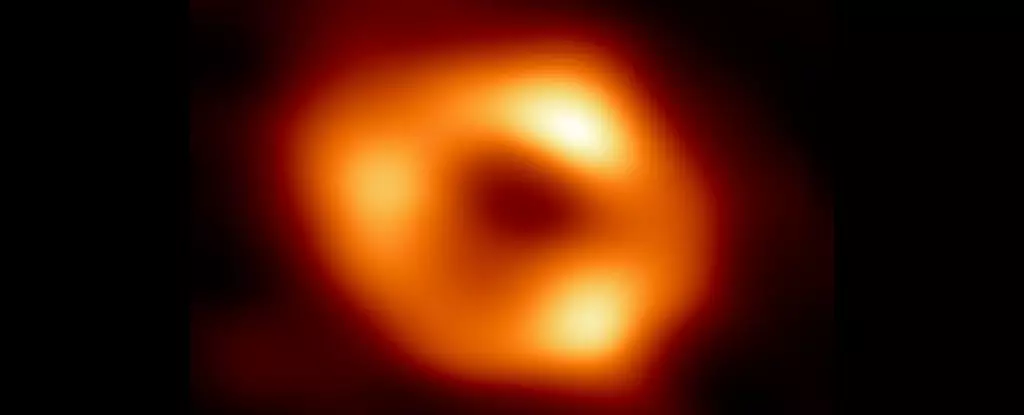The stunning imaging of Sagittarius A*, the supermassive black hole located at the center of our galaxy, captured the world’s attention in 2022. This groundbreaking photograph, produced by the Event Horizon Telescope (EHT) collaboration, showcased a bright ring formed by the accretion disk surrounding the black void of the black hole itself. However, researchers from the National Astronomical Observatory of Japan (NAOJ) are now challenging the previously established narrative by suggesting that this image does not accurately represent the true shape of Sgr A*. Their reanalysis asserts that the accretion disk might be elongated rather than circular, opening up new discussions about the complex dynamics at play in this cosmic behemoth.
The Complexity of Interferometric Imaging
The process of capturing and reconstructing images of celestial objects such as Sgr A* is fraught with challenges, particularly when utilizing radio interferometry. This technique relies on multiple radio telescopes spread across the globe to collect data that can capture high-resolution images of astronomical phenomena. However, gaps in this data can occur, leading to potential inaccuracies in the final image. The researchers at NAOJ employed alternative analytical methods to reassess the originally captured data, hinting that the bright ring—so iconic in the EHT’s presentation—could be an artifact resulting from the imaging process itself.
According to NAOJ astronomer Miyoshi Mikato, the previously established circular structure may not reflect the actual his morphology of the accretion disk. “The rounded appearance may arise from errors during EHT’s imaging analysis,” Miyoshi suggested. This perspective illustrates the inherent complexities and limitations of astronomical imaging and reiterates the need for ongoing refinement of techniques.
Reconstructing the Image: A Different Perspective
The NAOJ’s re-analysis leads to a radically different representation of Sgr A*, characterized by an elongated shape predominantly oriented in the east-west direction. Notably, their image suggests that the eastern segment of the accretion disk exhibits a brighter intensity than its western counterpart. This divergence indicates more than just a visual difference; it hints at the physical processes at work within the disk itself.
The imbalance in brightness could be attributed to the Doppler effect, a phenomenon arising from the speed at which gas and matter are swirling around the black hole. According to the new analysis, the accretion disk rotates at an astounding rate of around 60 percent of the speed of light. As material spirals inward, it experiences immense friction and magnetic forces, generating significant heat that causes it to emit x-rays and various forms of electromagnetic radiation.
Understanding the morphology of the accretion disk around Sgr A* is crucial for elucidating the fundamental mechanics at play in supermassive black holes. Accretion disks are shaped by a multitude of factors, including the spin of the black hole, the rate at which material falls inward, and the angular momentum of that material. These variables together dictate how matter flows and accumulates before ultimately being swallowed by the immense gravitational force of the black hole.
Moreover, the gravitational effects exerted by Sgr A* could create visual distortions akin to those seen in a funhouse mirror, complicating efforts to achieve a clear imaging of the accretion disk. As Michio Mikato aptly pointed out, “No telescope can capture an astronomical image perfectly.” Consequently, discrepancies between the EHT’s circular representation and NAOJ’s elongated interpretation could simply reflect the intricate nature of the observational data, rather than definitive conclusions about the physical structure of Sgr A*.
Moving forward, both research teams recognize the complexities involved in astrophotography, especially regarding the EHT’s original insights into Sgr A*. The EHT’s endeavor was groundbreaking, marking the first comprehensive attempt to image a black hole and its surrounding environment. However, the inconsistency in findings speaks to the novelty of these scientific efforts and the potential for refining imaging techniques to yield more accurate depictions in the future.
Research surrounding Sgr A* will undoubtedly continue, with both the EHT collaboration and the NAOJ team working towards improved theoretical frameworks and observational methods. As technological advancements allow for higher resolution and reduced gaps in data, we can expect a clearer and more detailed understanding of the black hole’s accretion disk and the dynamic environment in which it exists.
While the initial portrayal of Sagittarius A* garnered widespread acclaim, the evolving analysis through different methodologies underscores the complexities of cosmic imaging. By continuously reassessing our astronomical observations, we are better positioned to appreciate the enigmatic beauty and fundamental workings of the universe surrounding us.

